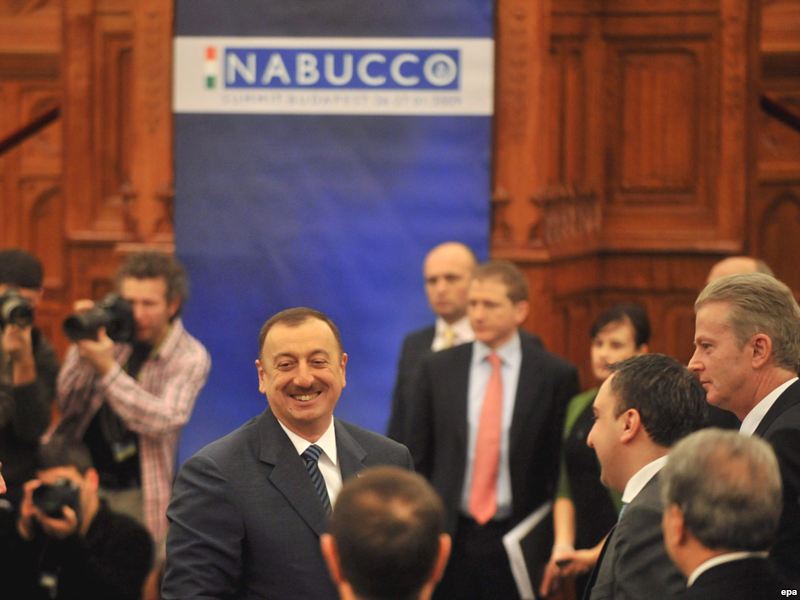
“Nabucco-West”: Abridged Pipeline Project Officially Submitted to Shah Deniz Consortium
Publication: Eurasia Daily Monitor Volume: 9 Issue: 98
By:

The Nabucco pipeline consortium has submitted a radically modified version of its project for consideration by the Shah Deniz gas producers’ consortium in Azerbaijan. The modified submission capped intense discussions within the Nabucco consortium, down to the wire of the May 16 deadline.
Its new version, Nabucco-West, involves a 1,300-kilometer pipeline running entirely on European Union territory, from the Turkish-Bulgarian border to the Central European Gas Hub at Baumgarten near Vienna. The pipeline’s previous version had been planned to run 3,900 kilometers, from eastern Turkey to Vienna. The revised version eliminates the Turkish section, shortening the pipeline’s length by two thirds and correspondingly reducing the construction costs. On EU territory, Nabucco-West proposes to take the same route as the original project. According to the project company’s management, Nabucco-West is designed for an initial capacity of 10 billion cubic meters (bcm) annually, “fully scalable” to meet future demand for gas transportation from the Caspian basin to Europe (Nabucco Gas Pipeline International Company press release, May 16).
Nabucco’s previous, decade-old version was succumbing to its built-in weaknesses by 2011. At that point, Azerbaijan initiated the Trans-Anatolia Pipeline (TANAP) jointly with Turkey, in effect replacing Nabucco on Turkey’s territory up to the EU border. This made possible Nabucco’s re-invention as a continuation pipeline from TANAP into Central Europe, at a fraction of the “old” Nabucco’s length and cost, and with scalable capacity to accommodate growing gas volumes over time.
On EU territory, Nabucco-West inherits the “old” Nabucco’s legal framework. This includes the 2009 Inter-Governmental Agreement (IGA), 2010 Project Support Agreements (PSAs), and EU-approved exemptions from third-party access to the pipeline’s capacities. These amount to major competitive advantages over the other projects that compete for the same 16 bcm per year from the Shah Deniz project in Azerbaijan (see below).
TANAP itself is planned to be scaled up, from a first-stage capacity of 16 bcm annually (including 6 bcm for Turkey and 10 bcm for European markets) to as much as 30 bcm per year (equivalent to Nabucco’s ultimate capacity goal). Azerbaijan’s State Oil Company is slated to be TANAP’s majority shareholder and investor. TANAP’s construction time-table is correlated with Phase Two of Shah Deniz gas production in Azerbaijan, due to be on stream by 2017.
Turkey’s Energy Minister Taner Yildiz and the state-owned Botas company have welcomed the Nabucco-West project (Anatolia News Agency, Bloomberg, May 16). Botas is one of the six parity shareholders in the “old” Nabucco, as well as a minority shareholder in the TANAP project. According to Yildiz, the combination of TANAP and Nabucco-West guarantees sufficient transport capacity for the Shah Deniz producers’ consortium to proceed with the $22-billion investment decision in Phase Two of production.
Among the five Nabucco-West partners, Hungarian MOL and German RWE have expressed reservations about the modified project. MOL as well as Prime Minister Viktor Orban (whose government is a 25 percent shareholder in MOL) seem to share the general sense of Nabucco-fatigue that had overtaken many in the EU, including the European Commission, last year. Budapest currently seems more attracted to the British Petroleum (BP)-proposed South-East Europe Pipeline (SEEP), which would use Hungary as a potential hub, with interconnectors running to Croatia and Austria, respectively (in which case Austria would no longer serve as transit country and hub for Azerbaijani gas) (see EDM, May 11).
For its part, RWE has objected to downsizing the “old” Nabucco into Nabucco-West. The German company has also insisted on routing some gas volumes from Nabucco into the RWE-controlled transmission line in the Czech Republic, Transgas, on a long-term basis. MOL and RWE have hinted (separately from each other) that they consider the possibility of abandoning the Nabucco project (see EDM, May 11). Meanwhile, Economic Development Minister Zsuzsanna Nemeth has reassured all concerned that the Hungarian government remains committed to the EU-backed Southern Gas Corridor and does not intend to abandon the relevant international agreements – i.e., the Nabucco project’s legal framework (Magyar Nemzet, May 16).
The European Commission currently regards TANAP, Nabucco-West, SEEP and the Italy-bound Trans-Adriatic Pipeline (TAP, planned to run across Greece and Albania en route to the Adriatic and Italy) as potential components of the Southern Gas Corridor. At present, the Commission maintains neutrality between Nabucco-West, SEEP and TAP, all of which compete against each other over Shah Deniz gas. The Shah Deniz producers’ consortium will select one pipeline option to Central Europe, and then evaluate that winner against the Italy-bound TAP. Within the Shah Deniz consortium, BP is behind SEEP while Norway’s Statoil stands behind TAP, and Azerbaijan’s State Oil Company has its reasons to prefer Nabucco-West.
Those three rival projects each are an extension of TANAP. Only TANAP is unrivaled as the conduit for Azerbaijani gas and, potentially, Turkmen gas to Europe. Baku anticipates transiting Turkmen gas, on top of exporting Azerbaijani gas from Shah Deniz and other Azerbaijani projects from 2020 onward. A scalable Trans-Anatolia pipeline feeding into Nabucco-West would enable Azerbaijani gas to reach Baumgarten, with multiple marketing options along that route and from that hub. Conversely, Baku could choose the Greece-Italy route, in the hypothetical event of Azerbaijan winning the international tender for the Greek DEPA gas transmission system. Either way, if the Trans-Anatolia pipeline materializes as planned, Baku will have a strong say in selecting the continuation pipeline into EU territory.




